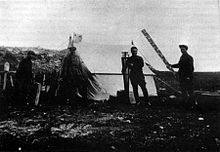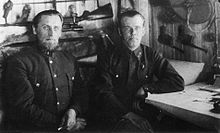Waigatsch expedition of the OGPU
The Waigatsch expedition of the OGPU ( Russian Вайгачская экспедиция ОГПУ ) later also Waigatschlag ( Russian Вайгачлаг ) took place from July 13, 1930 to 1936. Its aim was to develop the raw material deposits located on the 3383 km² arctic island of Waigatsch for the Soviet Union through mines operated by the central administration of the corrective labor camps (GULag). The Waigatsch expedition, like the construction of the White Sea-Baltic Sea Canal, was a project of the OGPU , which aimed to maximize the workforce of GULag prisoners. The Waigatschlag single camp was one of the GULag's most northerly penal labor camps.
prehistory
In the course of the expansion of the camps for special use, which began in June 1929 (SLON, from June 1930 ULag, August 1930 GULag), the deputy chairman of the OGPU Genrich Jagoda proposed on April 12, 1930, in addition to the replacement of forced labor camps by forced resettlement colonies (→ tragedy of Nasino ) the colonization of the north of the Soviet Union for the exploitation of previously unused raw material deposits. The island of Waigatsch offered itself for such an undertaking, as a geological expedition led by Nestor Alexejewitsch Kulik (1886–1942) discovered a deposit of polymetallic ores in the southwestern part of the island. In 1925, the Warnek Bay was called by the Novaya Zemlya Expedition of the Academy of Sciences of the USSR and ore samples were taken there. The examination of the ores showed a high content of lead and zinc. Traces of gold were also found. Since the OGPU leadership speculated on the discovery of precious metal deposits, Fjodor Eichmans , the head of the ULag, received the order on May 1, 1930 to equip an expedition consisting mainly of prisoners, to start mining the ore deposits that had already been discovered and the entire island to explore geologically.
Beginning of the expedition
In early July 1930, a four-ship convoy left Arkhangelsk in the direction of Waigach. It consisted of the icebreakers Sedow and Malygin and the freighters Mjatel and Gleb Boki belonging to the ULag . On July 17, 1930, the convoy anchored in Warnek Bay. They were the first ships to call at Waigatsch Island in 1930. The cargo of the icebreaker Sedow consisted mainly of numbered and cut wood, which was needed for the construction of a base. In addition, the cargo of the Sedov included necessary items and supplies for wintering on the island. The cargo ships Mjatel and Gleb Boki transported a total of 125 GULag prisoners, whose task was the construction of the Warnek base and the construction of the first mine near the bay. The prisoners who took part in the expedition had previously been selected in the special camp on the Solovetsky Islands on the basis of their professional skills. On the Malygin there was a group of geologists who were responsible for the targeted installation of the digs. There were also lorries and other mining material on the ship that had been procured from the USA by the industrialist Armand Hammer .
First wintering
A total of 132 people were supposed to survive the first winter on Waigatsch Island. The inmates worked ten to twelve hours a day to complete the urgently needed residential buildings. In November, Warnek consisted of five buildings - a house for the radio transmitter, a canteen, a medical post, a barrack for the prisoners and the house for the leader of the expedition and his assistants. In August 1930 a Dornier Wal flying boat was stationed in Warnek. In September 1930 pits number 1 and number 2 were dug on the Cape Rasdelny peninsula opposite the Warnek base. A sorting system for the ore extracted was built above ground. Within two months, 120 tons of ore containing at least 20 percent lead and zinc were extracted in these mines. The mostly manual work in the mines was very dangerous to health due to the lead dust that was generated. (→ Pneumoconiosis ) When further pits were being built, the miner Atlanov died in an explosion on April 7, 1931.
Generally speaking, the expedition made good progress by the summer of 1931. Eichmans turned out to be a good organizer. De facto, no distinction was made between GULag prisoners and free personnel within the Warnek base. All persons could move freely. The workers were well fed.
Expansion of funding
On August 10, 1931, the geologist Pawel Wittenburg came to Waigatsch. He was appointed head of the expedition's geological department and was responsible for further exploration of the island. In September 1931, the steamer Gleb Boki transported more prisoners to the island. The expedition now consisted of 334 people.
With the help of the additional workforce, further zinc mines were opened on Lake Paigoto. The exploitation of these deposits turned out to be difficult, as the ore could not be removed as easily as at Cape Rasdelny.
At the beginning of 1932, the analysis of samples from the mines at Cape Rasdelny as well as from Lake Paigoto and from the shore of Dyrowataja Bay showed that no precious metals could be found on the island. The need for the presence of a high-ranking OGPU member like Eichmans was no longer a given. Eichmans left the island on May 8, 1932.
In 1932 2745 tons of ore with a grade of 29.1% lead and zinc were mined. Of this, 2,420 tons were transported away by ship. In the same year, the geologist Wittenburg succeeded in discovering a fluorspar deposit near the Amderma river. This led to the creation of a mine in 1933, which ensured the independence of the Soviet Union from imports of this raw material until the end of the Second World War and the establishment of the town of Amderma , which still exists today.
On October 30, 1933, another prisoner transport came to Waigatsch. Warnek's population grew to 1,100. With the arrival of the additional workers, the living conditions for the miners deteriorated. By the end of 1933, the preparatory work for industrial mining had been completed.
Waigatschlag single camp and end of mining activities
On July 31, 1934, the exploration of copper mines in the Dyrowataja Bay began.
On August 20, 1934, the Waigatsch expedition was renamed the Waigatsch single camp point (Waigatschlag for short). At the end of 1934, 1,209 prisoners were working in the mines.
The Warnek settlement continued to grow until 1936. Deserved prisoners like Pawel Wittenburg were given the right to bring their families to Waigatsch. This is how more residential buildings and a school were built. Then sea water broke into the profitable mines on Cape Rasdelny. Since the water could not be pumped out, the shafts became unusable. The camp was then disbanded. The personnel and important material were transferred to Amderma and the Ukhta Pechora camp.
Second Waigatsch expedition
A second Waigatsch expedition was started in 1940. After wintering, the expedition was canceled in 1941 in the wake of the beginning of the German-Soviet war .
literature
When using Soviet sources, with the exception of samizdat and tamizdat literature, which was published up to 1987, the activities of the Soviet censorship authorities ( Glawlit , military censorship) must be taken into account when revising various contents in line with Soviet ideology. (→ censorship in the Soviet Union )
- W. Yes. Dworschezkij: Great Stages of the Way: Memoirs of an Actor. ( Russian В. Я. Дворжецкий: Пути больших этапов: Записки актёра. ), Возвращение Moscow. 1994 ( online , Russian)
- KP Gurskij: My Waigatsch: (Memoirs). , Museum of Local History of the Nenets District, Narjan-Mar 1999. ( Russian К. П. Гурский: Мой Вайгач: (записки заключенного) , Ненец. Окруж., Краевед. Маер 1999 ).
- AN Loiko, EN Loiko, AN Loiko: An unfinished story: The biography of the Russian aviator Iwan Loiko. ( Russian А. Н. Лойко, Е. Н. Лойко, А. Н. Лойко: Неоконченная повесть: История о русском летч.оке Иване Лойкике Иване-. 2006, Tomorrow 2006 , Scientific 5-9 . ISBN 978-5-93629-210-1 ( online , Russian)
- Oleg V. Khlevniuk: The History of the Gulag. From Collectivization to the Great Terror. , Yale University Press 2004. ISBN 0-300-09284-9
- Tomasz Kizny: Gulag , Hamburger Edition 2004, ISBN 3-930908-97-2 , ISBN 978-3-930908-97-4
- Vyacheslav Makeev: The Nenets Autonomous Okrug . ( Russian Вячеслав Макеев: Ненецкий Автономный Округ ), Petit Futé, 2003, ISBN 5-86394-197-9
- Alexander Solzhenitsyn : The GULAG Archipelago , Volume 2, Rowohlt Hamburg 1994, ISBN 3-499-14197-3 .
- Pawel W. Wittenburg: The ore deposits of the island Waigatsch and of Amderma. , Moscow 1940. ( Russian П.В. Виттенбург: Рудные месторождения острова Вайгач и Амдермы. )
Web links
- Sergei Krivenko: Memorial - WAIGATSCH EXPEDITION OF THE OGPU , accessed on October 27, 2013
Individual evidence
- ↑ a b c Sergei Kriwenko: WAIGATSCH EXPEDITION OF THE OGPU . Memorial . Retrieved October 27, 2013.
- ↑ Khlevniuk: The History of the Gulag. , P. 23
- ↑ Кулик Нестор Алексеевич (1886–1942) (Russian), accessed November 1, 2013
- ↑ Makeew: Autonomous Circle of the Nenets , p. 167
- ↑ Solzhenitsyn: The GULag Archipelago , Volume 2, p. 541
- ↑ a b Gurskij: Mein Waigatsch , p. 5
- ↑ Gurskij: Mein Waigatsch , p. 6
- ↑ a b Gurskij: Mein Waigatsch , p. 7
- ↑ Khlevniuk: The History of the Gulag , p. 86
- ↑ Gurskij: Mein Waigatsch , p. 8
- ↑ Makeew: Autonomous Circle of the Nenets , p. 168
Remarks
- ↑ The bay and the place of the same name that exist today are named after the Russian captain and polar explorer Alexander Iwanowitsch Warnek (1858–1930).
Coordinates: 69 ° 42 ′ 56.6 ″ N , 60 ° 1 ′ 35.6 ″ E


